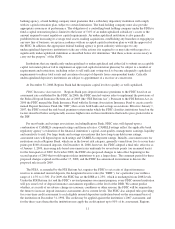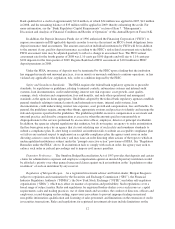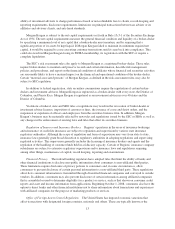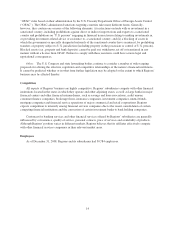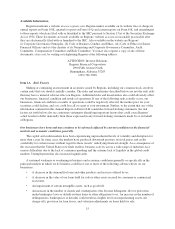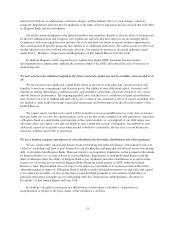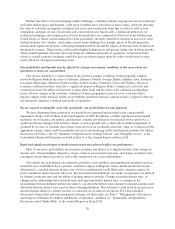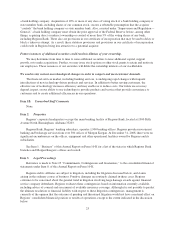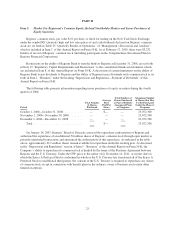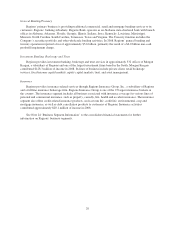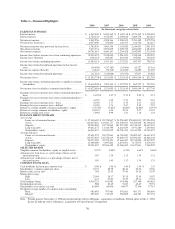Regions Bank 2008 Annual Report Download - page 30
Download and view the complete annual report
Please find page 30 of the 2008 Regions Bank annual report below. You can navigate through the pages in the report by either clicking on the pages listed below, or by using the keyword search tool below to find specific information within the annual report.Further, the effects of recent mortgage market challenges, combined with the ongoing decrease in residential
real estate market prices and demand, could result in further price reductions in home values, adversely affecting
the value of collateral securing the residential real estate and construction loans that we hold, as well as loan
originations and gains on sale of real estate and construction loans.Specifically, a significant portion of our
residential mortgages and commercial real estate loan portfolios are composed of borrowers in the Southeastern
United States, in which certain markets have been particularly adversely affected by declines in real estate value,
declines in home sale volumes, and declines in new home building. For example, prices of Florida properties
remain under significant pressure, with rising unemployment levels and the impact of the real estate downturn on
the general economy. These factors could result in higher delinquencies and greater charge-offs in future periods,
which would materially adversely affect our financial condition and results of operations. A decline in home
values or overall economic weakness could also have an adverse impact upon the value of real estate or other
assets which we own upon foreclosing a loan.
Our profitability and liquidity may be affected by changes in economic conditions in the areas where our
operations or loans are concentrated.
Our success depends to a certain extent on the general economic conditions of the geographic markets
served by Regions Bank in the states of Alabama, Arkansas, Florida, Georgia, Illinois, Indiana, Iowa, Kentucky,
Louisiana, Mississippi, Missouri, North Carolina, South Carolina, Tennessee, Texas and Virginia. The local
economic conditions in these areas have a significant impact on Regions Bank’s commercial, real estate and
construction loans, the ability of borrowers to repay these loans and the value of the collateral securing these
loans. Adverse changes in the economic conditions of these geographical areas for over a year have had a
negative impact on the financial results of our banking operations and may continue to have a negative effect on
our businesses, financial condition and results of operations.
We are exposed to intangible asset risk; specifically, our goodwill may become impaired.
We have determined that a portion of our goodwill was impaired and recorded a non-cash goodwill
impairment charge of $6.0 billion in the fourth quarter of 2008. In addition, a further significant and sustained
decline in our stock price and market capitalization, a significant decline in our expected future cash flows, a
significant adverse change in the business climate or slower growth rates could result in further impairment of
goodwill. If we were to conclude that a future write-down of our goodwill is necessary, then we would record the
appropriate charge, which could be materially adverse to our operating results and financial position. For further
discussion, see Notes 1 and 10, “Summary of Significant Accounting Policies” and “Intangible Assets”, to the
Consolidated Financial Statements included in Item 8. of this Annual Report on Form 10-K.
Rapid and significant changes in market interest rates may adversely affect our performance.
Most of our assets and liabilities are monetary in nature and subject us to significant risks from changes in
interest rates. Our profitability depends to a large extent on our net interest income, and changes in interest rates
can impact our net interest income as well as the valuation of our assets and liabilities.
Our current one-year interest rate sensitivity position is asset sensitive, meaning that an immediate increase
in interest rates would likely have a positive cumulative impact on Regions’ twelve-month net interest income.
Alternatively, a gradual decrease in rates over a twelve-month period would likely have a negative impact on
twelve-month net interest income. However, like most financial institutions, our results of operations are affected
by changes in interest rates and our ability to manage interest rate risks. Changes in market interest rates, or
changes in the relationships between short-term and long-term market interest rates, or changes in the
relationships between different interest rate indices, can affect the interest rates charged on interest-earning assets
differently than the interest rates paid on interest-bearing liabilities. This difference could result in an increase in
interest expense relative to interest income, or a decrease in our interest rate spread. For a more detailed
discussion of these risks and our management strategies for these risks, see Item 7. “Management’s Discussion
and Analysis of Financial Condition and Results of Operation” and Item 7A. “Quantitative and Qualitative
Disclosures about Market Risk” of this Annual Report on Form 10-K.
20



